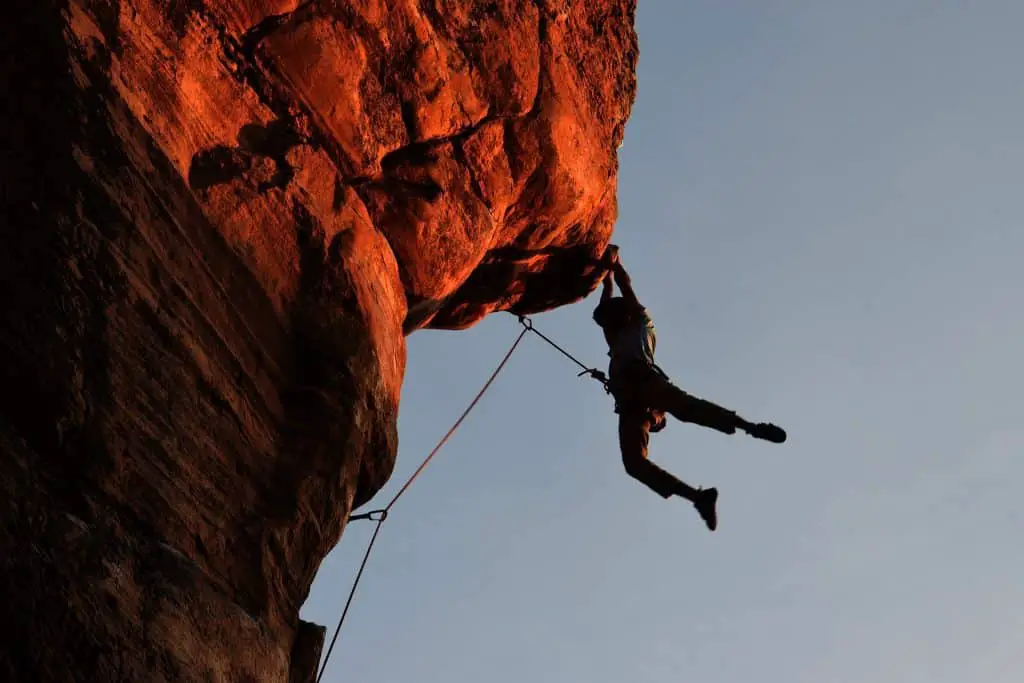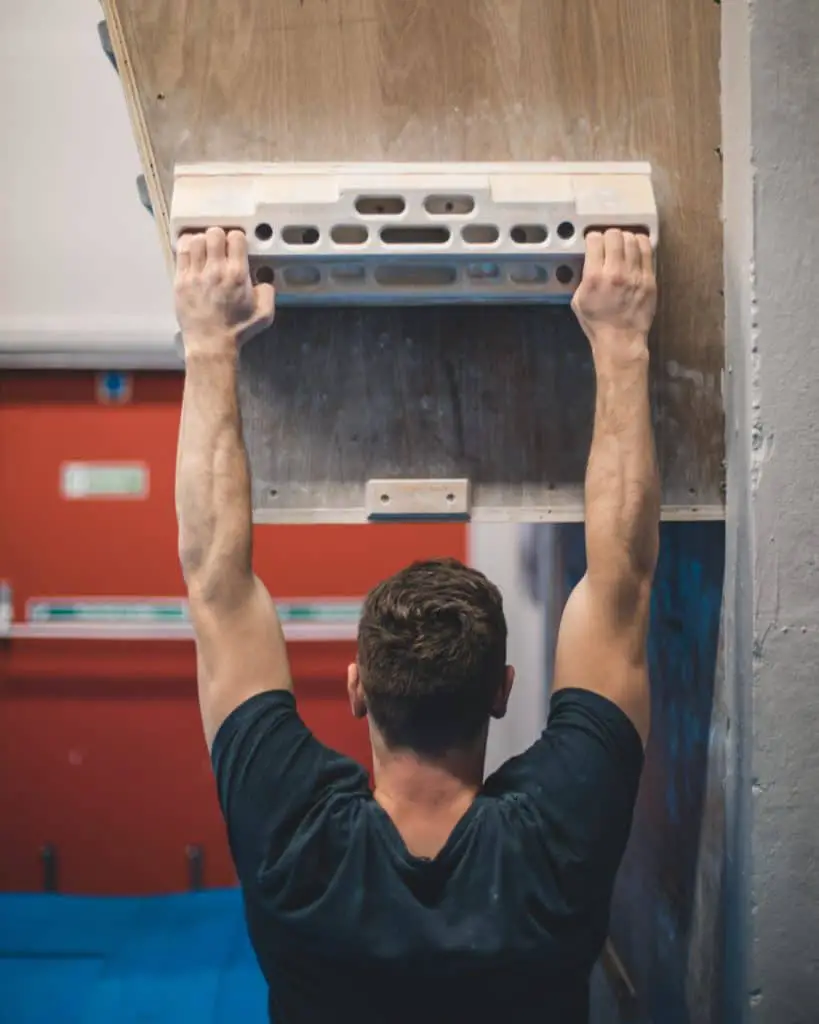
If you’re like me then you were naturally better at slabs and right angled walls rather than overhangs. In the early days I literally just used to ignore them because I wasn’t very good at them. However, I realised that if I wanted to improve my overall climbing ability I had to improve on overhangs. But it wasn’t that easy. Even though I had the drive to improve and was being coached by some very advanced climbers, I wasn’t progressing fast enough. So I started to wonder “how can you get better at overhang climbing?” So I started looking at the differences between climbing on overhangs and on slabs and found that they both worked the same muscles however the primary muscle groups that they worked were different. Plus the techniques used when climbing overhangs are usually very different to climbing on slabs and straight walls – how often do you see a toe hook on a slab? It’s uncommon, however on an overhang or cave climbing it’s a lot more common. Anyway, let’s look at improving your ability to climb overhangs in more depth.
So how can you get better at climbing overhangs? There are three main areas that need to be worked on if you want to see overall improvement in overhang climbing:
- Body tension/core strength
- Finger strength
- Footwork and general technique
Body tension may be your main problem because you might not be putting enough effort in with your core strength to stay on the wall. Gaining strength in your fingers is always going to be good to improve your overall climbing ability, however working on finger strength for the pinchy holds on overhangs is imperative to see improvement. Improving your technique sounds obvious but you really need to start focusing on where your feet are going. Last but not least, the last thing you need is motivation to keep practising the three areas mentioned. If you don’t practise then you won’t see improvement.
Page Jumps
- How to Progress on Overhangs with these 3 Areas
- Other Ways to Help Overhang Climbing Improvement
- How to Stay Motivated Even if You Can’t See Progress
- Related Questions
How to Progress on Overhangs with these 3 Areas
Now, it’s obvious that depending on your climbing grade that you might improve on climbing overhangs more slowly or more quickly, so please keep that in mind. But in this section we’re going to going through the three areas mentioned earlier in detail.
How to Use Body Tension & Core Strength to Improve Climbing Overhangs
When you look at slab climbing, body tension and core strength isn’t used as much as overhang climbing. I find slab climbing a very patient art that requires balance, and (usually) very little strength. And if you see a beginner climbing overhangs really well then typically they’ve come from a more athletic background and are quite strong especially in their core. This is the main reason why you might find slab climbing and straight walls to be a lot easy that overhangs and roof climbing. You need to improve your core strength and body tension. Now there are ways to do this, first of all you can start climbing overhangs more often, and when you do you want to use your core to hold you up as much as possible with every more. While overhang climbing, try to include your core through every move, specifically with the aim to gain strength in that area. Once you’ve gained the strength in that area you won’t need to focus on tensing your core on certain climbs because you’ll do it naturally. If you’ve done this correctly you’ll feel sore in your abdominals, oblique muscles and lower back muscles for the next couple of days.
Another way to improve your core strength is to make a weekly core workout routine. Three days out of the week could be devoted to improving your core strength. Here’s a typical core workout routine (you can increase or decrease the amount of reps you do):
- 20 Sit Ups
- 15 Crunches
- 15 Leg Raises
- 20 Second Plank
Repeat once.
This routine does not take long and can really help you gain core strength and therefore improve your overhang climbing ability.
How to Gain Finger Strength to Improve Climbing Overhangs
Whether it’s overhang climbing or slab climbing, finger strength is one of the main things you’ll need to progress through the grades. It is probably one of THE most important factors (other than technique) for improvement, and it’s not that hard to gain finger strength if you devote time to it. If you don’t have naturally strong hands then this can take a lot more time for you than others, but if you really want to get better at climbing you’ll do it anyway. And if you can usually complete a move or transition with larger holds but can’t with smaller or more pinchy holds then you need to gain strength in your fingers.
So what’s the best way to gain finger strength for climbing? Using a hangboard is hands down the best way to gain finger strength. You can’t usually find a hangboard at your local climbing gym, however you can also buy them and fit them in your home. Here’s a hangboard exercise to help you gain finger strength which I’ve taken from my recommended hangboards page:
I suggest you try out a 30 day cycle. Time how long you can hang on to each finger hold with both hands before your 30 day regime, and then do the same at the end of the 30 days. This will show you just how much your finger strength/endurance has improved.
The exercise:
- Have a phone timer or stopwatch nearby.
- Place both hands into the deepest rung – four fingers in, thumbs out.
- Hang for 10 seconds.
- Rest for 10 seconds.
- Repeat this another 4 times (5 times total)
- Rest for 3-4 minutes making sure your body has fully recovered.
- Repeat this whole cycle 6-7 times in total.
- Do this either every day or every two days for required results.
- You should be able to hang for at least 7 seconds, at most 11 seconds before you feel fatigue in your fingers.
- Once you get good enough, do this on the more shallow rung.
- If your fingers need even more strength, add 5lb or 10lb weights to your body.
After around 10-15 days of doing this exercise DAILY you should probably be feeling a difference with your climbing. Some of the holds you might usually avoid may be easier to grab.

How to Use Footwork and Technique to Improve Climbing Overhangs
Footwork is crucial when it comes to overhang climbing. If you find you’re cutting your feet a lot then you aren’t using your feet to your advantage. Cutting feet is a skill and is a good technique to use every now and then on some climbs, however it does put pressure on your upper body to work more and take all of your body weight. Although campusing is useful on overhangs, it also means you’ll get tired faster. Try to cut feet less and, instead, use them to help you climb.
Toe hooks are common on overhangs, and if you’re going to be climbing overhangs a lot more then you might want to think about getting shoes that are specifically built for toe hooks like the Scarpa Instinct VS which has a rubber patch on the toes made for toe hooking.
Learning how to use the bicycle technique is crucial on overhangs. When doing this move you simultaneously use a pull and push action with your feet on holds. This creates ultimate stability. You do need to be actually working here though, you can’t just PUT your feet on these holds – you need to push and pull with your feet which does require some effort.
Heel hooks are often quite common on overhangs you’ll need to not only recognise, but also try to use them where they seem to be needed. I know some climbers will understand that a hold is set as a heel hook but try to get around it in a different way because they don’t like to heel hook. That isn’t very good if you want to improve your overall climbing ability.
Another thing to remember is that when you’re reaching for a hold with your right hand, try to push more with your right foot on a hold to prevent yourself from barn dooring (where the body swings off the wall due to being off balance). If you’re reaching with the left hand then push with your left foot.
Using straight arms where you can take a lot of the tension away from the climb. If you aren’t pulling too much with your arms then they’ll be able to last a lot longer.
Other Ways to Help Overhang Climbing Improvement
Once you understand the above ways to improve you overhang climbs, you might want to think about losing some weight if you aren’t in good shape. If you’re carrying some excess weight then you’re going to put a lot of strength into your arms and core as they take you up the wall. The less weight you are the easier it is to pull yourself up the wall.
If you’re finding it too hard at first then you simply might be climbing grades that are too hard for you. You might be able to climb V6 on slabs but only V4 on overhangs. Find out what works best for you to progress as fast as possible.
How to Stay Motivated Even if You Can’t See Progress
I found that if I make a routine or training plan for my climbing session then it helps me to stay motivated to work on all different areas. My routine depends on how much time I have through that certain day to climb, however it always starts with a warm up and ends with a cool down. Hangboarding is thrown in just after the warm up to get my fingers ready for the session. Let’s say you have 2 hours to spend climbing. That’s a 10-15 minute warm up, 15 minutes hangboarding, 45 minutes on slabs and straight walls, 30 minutes on caves and overhangs and a 15 minute cool down.
Once you’ve made a routine or training plan for your climbing sessions and started improving the areas explained throughout this article, take a video of you climbing overhangs and remember the grade you’re climbing now. In 28 days take another video and see what you grade is then. If you don’t see improvement then keep trying or try to understand where/if you’re going wrong.
Related Questions
What does it mean to cut feet in climbing? Cutting feet is when you’re moving dynamically to a hand hold and your feet come off the wall. Sometimes the climb can’t be done without using this method, however for a lot of routes cutting feet can actually be of more effort than just keeping the feet on holds.
What is flagging in climbing? Flagging is when you use a foot that’s not on a foot hold to counterbalance yourself on the wall therefore preventing yourself from falling due to a barn-door.
